No one likes getting cooped up in one place. Don’t you enjoy taking study breaks outside? Your dog’s the same way. Training sessions are more fun when they happen in different places. And, for certain behaviors, you NEED to venture into the great outdoors. How to juggle the various grades of dog training treats you might need, though? No one wants to haul a giant backpack with them. Luckily, dog training pouches came along to solve that very problem.
Outdoor Training
Some behaviors work just fine in the comfort of your own home. You’ve probably managed to teach your dog to “sit,” “lay down,” and “shake” in your living room or kitchen. Those behaviors don’t require a lot of space (unless you have a giant breed dog).
What about teaching a recall behavior, though? If you take your dog hiking, such a command is crucial. That isn’t as easy to manage, even in a backyard. And fetch in the dining room tends to lead to breakage.
This means packing up the leash and harness and venturing to the local park with your handy dog training pouch.
The ABCs of Pouches
If you prefer, you can toss your dog training treats into a Ziploc bag and call it done. However, there are a couple of downsides to that option:
- It’s not hands-free. Training sessions demand that you provide a treat as soon as your dog executes the behavior. If you have to pause to open that bag, it’s time wasted. Dog training pouches are worn at your waist on a carabiner or belt loop, keeping your hands available to reach for the treats.
- Plastic anyone? Face it, all that plastic isn’t good for the environment. You might be able to reuse your baggie a couple of times, but it’s going to get gross pretty quick. The pouch is designed for repeated use and cleaning, keeping trash OUT of the landfills.
- Dog snack. Dogs are smart, and their sense of smell eclipses our own. They know what’s in that flimsy bag. If you turn your back, what are the odds it’ll last five seconds? Dog training pouches have a better chance of holding up (and you’ll be wearing it – out of reach).
Dog training pouches let you (and your dog) focus on the training session. You’re not trying to wrangle treats out of a bag (not to mention trying to get the bag out of your pocket or wherever you’re keeping it) while your dog loses interest in whatever you were working on. When you’re out in the open with other potential distractions, the focus is KEY.
Choosing a Dog Training Pouch
Dog training pouches have undergone a few design changes over the years. They went away from the fanny pack look, only to embrace it once again. Some are larger than others, and the materials used vary from fabric to silicone. You’ll need to decide which design works best for you, but keep these key features in mind:
- Portability: Dog training pouches need to attach to you SOMEHOW. This may consist of a clip, a Velcro strap, a carabiner, or even a loop for your belt. Some come with multiple options, giving you a choice of how to carry the pouch.
- Pockets: Who doesn’t love pockets? If you can tuck your keys, poop bags, or cell phone into the pouch, it’ll free up your hands even more.
- Closure: You don’t want your dog to help themselves to those treats. You need some way to close the dog training pouch when you’re not using it. You can find magnetic snaps, drawstrings, or even zippers.
- Water-Resistant Material: Odds are, you’re not training in the rain. However, dog slobber happens. You want a material you can wipe down.
- Washability: You’re putting FOOD into these dog training pouches. Eventually, you’re going to have to clean them. The easier they are to wash, the better.
- Dividers: Dog training treats are divided by grades. If you can find a dog training pouch with walls to separate your treats, this will make those training sessions run smoother.
- Size: Do you have a large dog? Or are you working on a new behavior that’s going to require a lot of treats? Tiny dog training pouches may be more discreet, but they won’t hold much. Think through the most appropriate size you’ll need.
Best Dog Training Pouches
Dog training pouches give us the chance to carry rewards for our dog with us at all times. Attach the pouch to your belt as you head out the door, and you’re ready to go. They’re perfect for camping trips, hiking trails, or even walks in the park. You can maintain one hand on the leash while you open the pouch with the other to reach for a treat. It beats making your dog stop, wait, and wonder why you’re dancing around for something in your pocket (entertaining everyone around you). Dog training pouches keep everything smooth and fluid.
Best Basic Dog Training Pouches
You’re heading out to the park to run a quick training session. You want to have a dog training pouch on hand during the potty-training process. Or you prefer to keep your accessories on the discreet side. You may want a simple, basic design. There’s nothing wrong with that. Functional works, right? If you want a workable pouch, these are the dog training pouches for you.
AUDWUD provides the simplest dog training pouch. The silicone dog pouch clips onto your belt and features a magnetic closure. When you’re ready to clean it, toss it in the dishwasher. (Doesn’t get easier than that!) This dog training pouch works perfectly with those extra-smelly high-value dog treats you don’t want to linger around. It’s lightweight, and you have an array of fun colors to choose from.
Downsides? The clip doesn’t stay in place very well. In fact, some people reported it fell off entirely. You may want to consider an alternative way of securing it.
The Good
- Magnetic closure
- Lightweight
- Pouch is dishwasher safe
The Bad
- Belt clip doesn't stay in place
If you want a basic dog training pouch, Chuckit’s the option for you. No bells and whistles, just a single pouch. You can place up to a cup of treats in the lined pouch. A drawstring keeps those treats safe and sound, and the pack-cloth fabric repels water.
The downside? The drawstring can get tricky to manipulate one-handed.
The Good
- Holds up to 1 cup of treats
- Lined pouch
- Water-resistant pack-cloth exterior
The Bad
- Drawstring difficult to close one-handed
There’s nothing wrong with simple. Outward Hound offers a single pouch on a belt clip. The drawstring closure cinches closed when you’re not using it, keeping out your crafty dog. The water-resistant exterior protects against slobber, and the entire pouch is washable when you’re finished.
So what are the downsides? The belt clip isn’t the strongest out there – treat it gently. And, again, the drawstring wasn’t always a favorite with people.
The Good
- Washable
- Water-resistant exterior
The Bad
- Belt clip isn't very strong
- Drawstring difficult to close one-handed
Best Multifunctional Dog Training Pouches
Sometimes, more is more. If you like to maximize your dog’s accessories, these are the dog training pouches for you. You still get space for training treats, but you also get a little bit more. Pockets, space for poop bags, and even extra rings. You can keep your clicker attached (so you don’t lose it), leave your wallet at home, and even incorporate your pouch into your daily walking routine. You’ll need to compromise on the size of your dog training pouch, but if you get some more function out of it, isn’t it worth it?
Doggone offers the most pocket space of any dog training pouch. You have a central interior that can hold up to THREE CUPS of treats, with an additional Velcro divider if you want to grade your treats. Two extra pockets on the sides provide plenty of room for any accessories or keys you might want to bring along for the trip. You can choose from a waistbelt or belt clip for securing the pouch, all in the same durable nylon. The compartment uses a magnetic closure to prevent sneaky dogs from prying an extra treat. And, of course, the entire dog training pouch pops into the wash for easy clean-up.
So what are the downsides? People tend to overload the pouch with all of that space, creating a heavy weight at their hip. Just take it easy and maybe skip the full three cups of treats. The magnet is fantastic until you can’t pry it open one-handed. And it sometimes opens on its own, depending on how you twist or move.
The Good
- 2 options for portability
- Holds up to 3 cups of treats
- Divided compartments
- Washable nylon
The Bad
- Can get heavy if overloaded
- Magnetic closure can be unreliable
Paw Lifestyle provides everything you could want from a dog training pouch. You have three different options for portability: a shoulder strap, a waistband, or a metal belt clip. The outside is water-resistant to protect against sudden rainstorms or doggie drool. The top features a drawstring closure to keep out curious dogs but allows you to access the treats inside quickly. You get the bonus of a mesh pocket to hold your phone or keys, as well as a zippered pocket if you want a little more security. There are even two handy D-rings on the side so you can keep your clicker and a favorite toy close by. Want even more? There’s a built-in poop bag dispenser! The entire pouch is constructed from washable nylon.
Downsides? For those who want a sleek, discreet dog training pouch, this one’s on the large and bulky side of things. There were also a few complaints about the stitching not always holding up, so try to go a little easy on your pouch.
The Good
- 3 options for portability
- Water-resistant exterior
- Pockets, side D-rings, and built-in poop bag dispenser
- Washable nylon
The Bad
- Dog training bag is on the bulky side
- Stitching not durable
PetAmi is another dog training pouch with multifunction capability. You have the option of a shoulder strap, waist belt, or belt clip, allowing you to choose your portability. A zippered pouch on the front lets you carry your keys or clicker as you head out for your training session. A poop bag dispenser on the back continues to keep your hands free while you’re out on your explorations. And you have the option of a hue of different colors, letting you match your dog’s personality.
Downsides? The closure features a drawstring, and it’s not always easy to open. Nor does it close all the way, allowing intelligent dogs to get their snout down into those treats.
The Good
- 3 options for portability
- Zippered pouch and poop dispenser bag
- Washable nylon
The Bad
- Drawstring difficult to close one-handed
PetSafe’s dog training pouch is a little sleeker in design. You can either use the waist belt or a plastic belt clip to keep it in place. A clever hinge in the opening pops the main pocket wide when in use while sealing it shut when you want the treats protected. You have divided compartments to allow for grading your training treats and an outside zipper pocket for your cell phone. There’s also a bonus loop to keep your clicker with the rest of your training needs. The entire pouch is machine washable, making cleaning a cinch.
We have this dog training pouch, and it works well. It’s lightweight for hikes, and the hinge makes treats easy to access.
The downsides? The plastic clip tends to the flimsy side (confirmed), but the waist belt works fine. Treats DO get stuck down in the seam, so be careful about using smaller-sized treats.
The Good
- 2 options for portability
- Divided compartments
- Outside zippered pocket and side loop
- Washable nylon
The Bad
- Belt clip breaks easily
- Treats get stuck in seams
Class is in Session
When you have a dog training pouch, your dog has the potential to learn anywhere. You can work on complex behaviors, such as recall. There’s even a chance to reward good behavior when out on hikes or camping trips. Those little pouches open up a lot of opportunities.
So ditch those Ziploc bags. Your dog’s earned an upgrade to a dog training pouch!

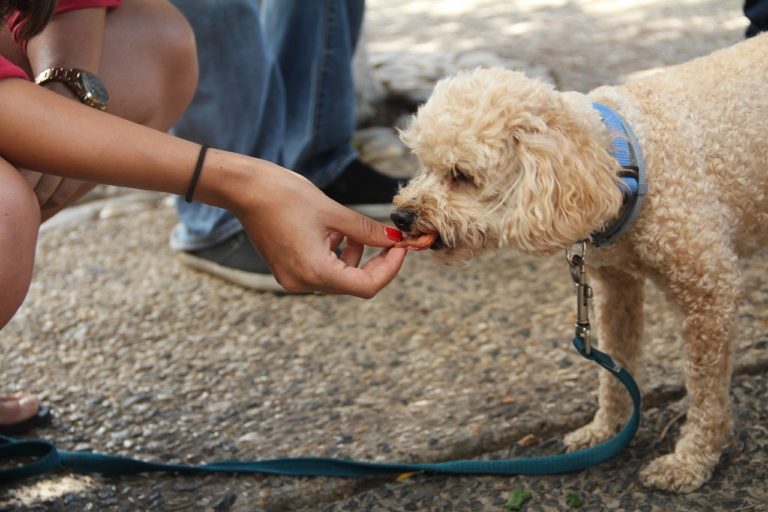
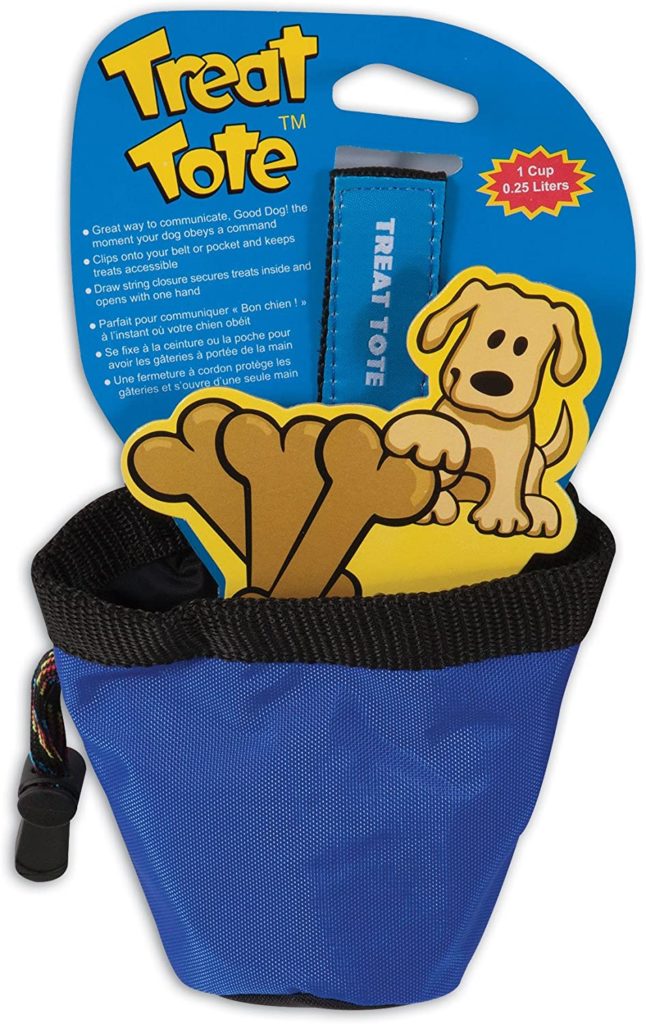
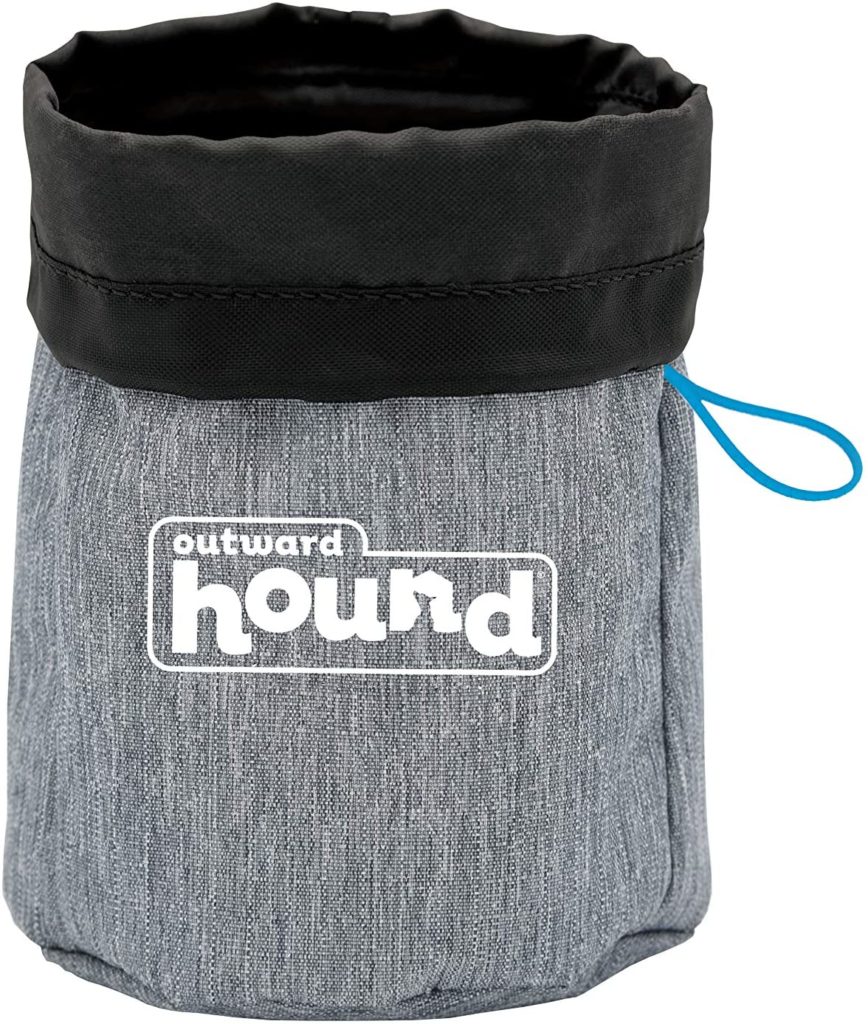
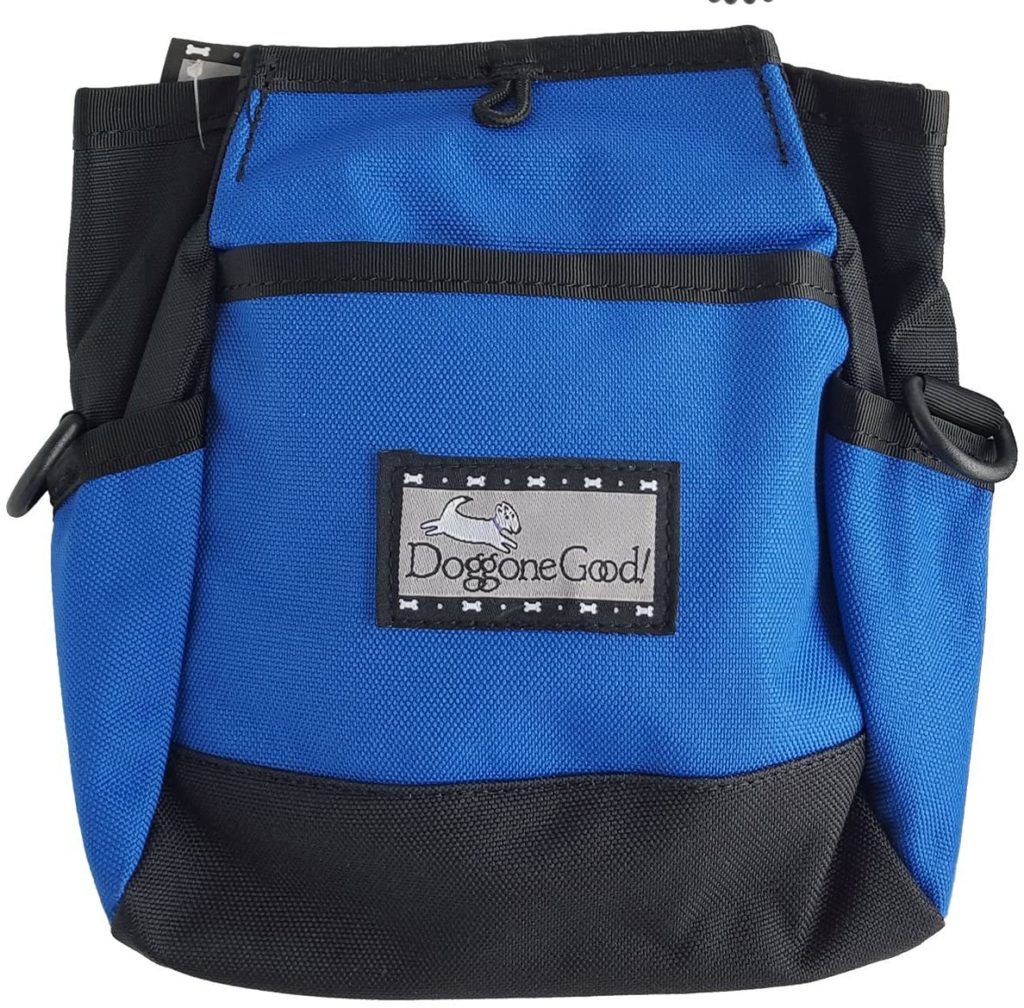
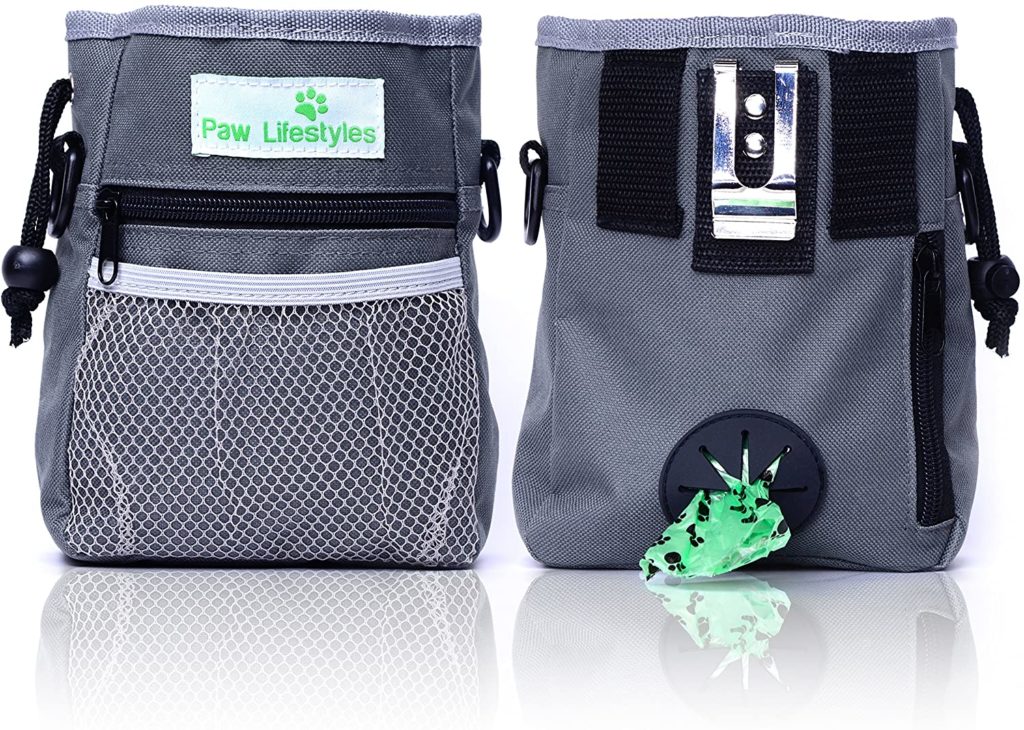
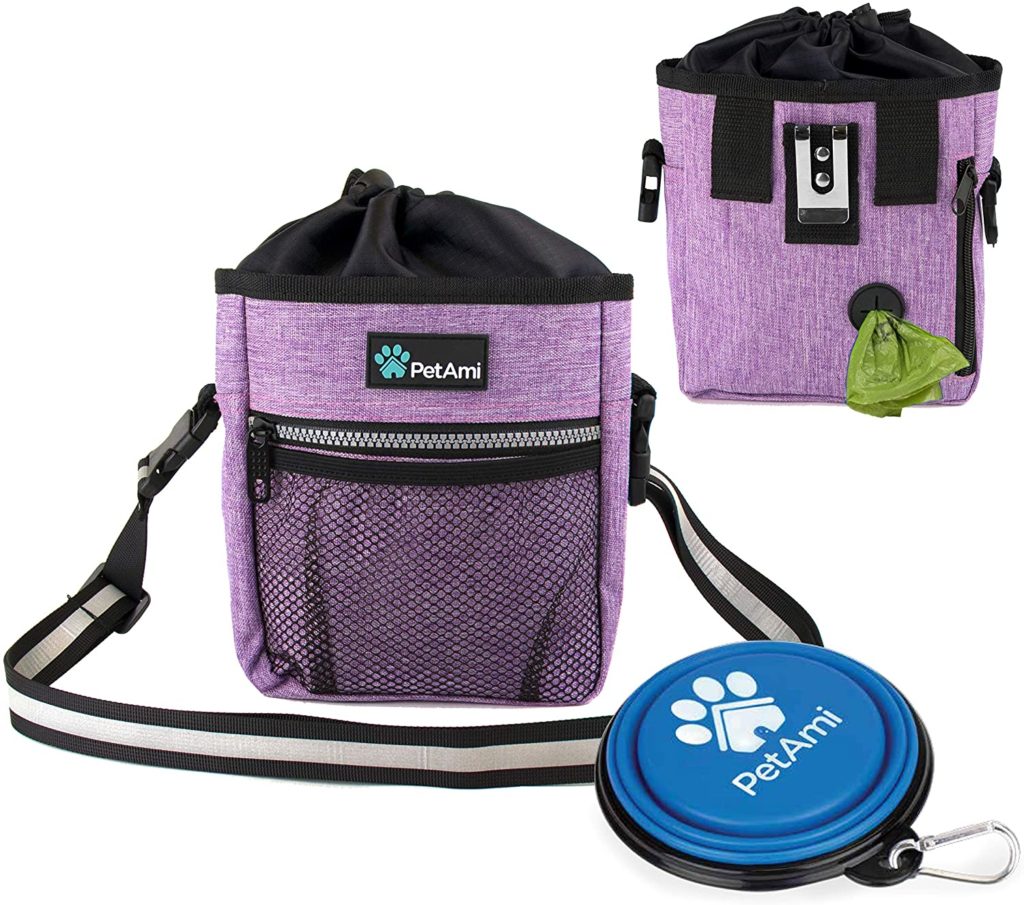
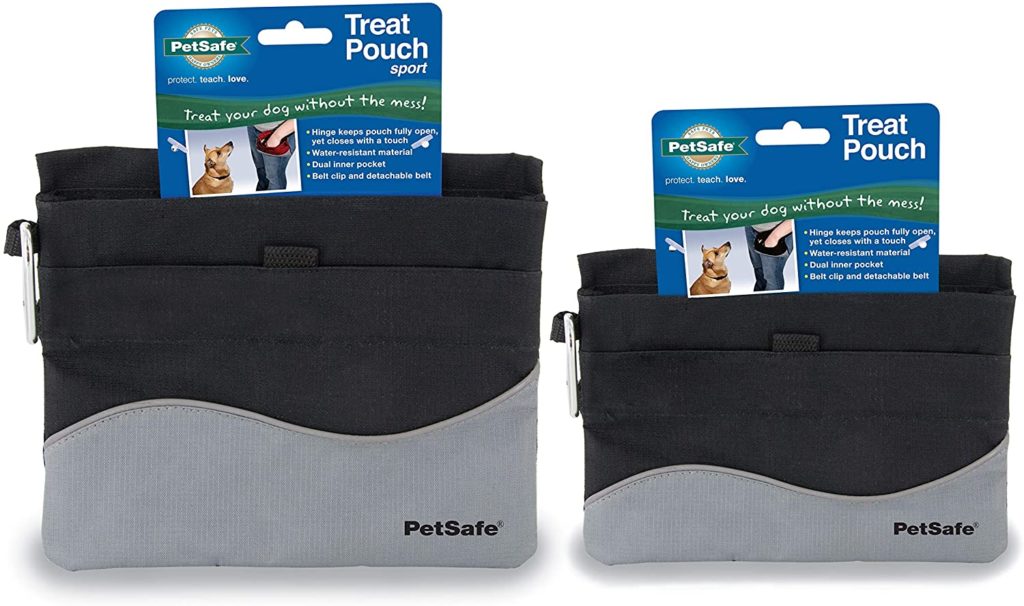




No comment yet, add your voice below!